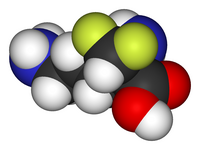Eflornithine
 |
|

Enantiomer R of eflornithin (top) and S-eflornithin (middle)
|
|
| Clinical data | |
|---|---|
| Trade names | Vaniqa, others |
| AHFS/Drugs.com | Monograph |
| License data |
|
| Pregnancy category |
|
| Routes of administration |
intravenous, topical |
| ATC code | |
| Legal status | |
| Legal status |
|
| Pharmacokinetic data | |
| Bioavailability | 100% (Intravenous) Negligible (Dermal) |
| Metabolism | Not metabolised |
| Biological half-life | 8 hours |
| Excretion | Kidneys |
| Identifiers | |
|
|
| Synonyms | α-difluoromethylornithine or DFMO |
| CAS Number | |
| PubChem CID | |
| IUPHAR/BPS | |
| DrugBank | |
| ChemSpider | |
| UNII | |
| KEGG | |
| ChEBI | |
| ChEMBL | |
| Chemical and physical data | |
| Formula | C6H12F2N2O2 |
| Molar mass | 182.2 g/mol |
| 3D model (Jmol) | |
|
|
|
|
|
|
|
Eflornithine, sold under the brand name Vaniqa among others, is a medication used to treat African trypanosomiasis (sleeping sickness) and excessive hair growth on the face in women. Specifically it is used for the 2nd stage of sleeping sickness caused by T. b. gambiense and may be used with nifurtimox. It is used by injection or applied to the skin.
Common side effects when applied as a cream include rash, redness, and burning. Side effects of the injectable form include bone marrow suppression, vomiting, and seizures. It is unclear if it is safe to use during pregnancy or breastfeeding. It is recommended typically for children over the age of 12.
Eflornithine was developed in the 1970s and came into medical use in 1990. It is on the World Health Organization's List of Essential Medicines, the most effective and safe medicines needed in a health system. There is no generic version as of 2015 in the United States. In the United States the injectable form can be gotten from the Center for Disease Control. In the 1990s the cost of a course of treatment in Africa was 210 USD. In regions of the world where the disease is common eflornithine is provided for free by the World Health Organization.
Sleeping sickness, or trypanosomiasis, is treated with pentamidine or suramin (depending on subspecies of parasite) delivered by intramuscular injection in the first phase of the disease, and with melarsoprol and eflornithine intravenous injection in the second phase of the disease. Efornithine is commonly given in combination with nifurtimox, which reduces the treatment time to 7 days of eflornithine infusions plus 10 days of oral nifurtimox tablets.
...
Wikipedia
